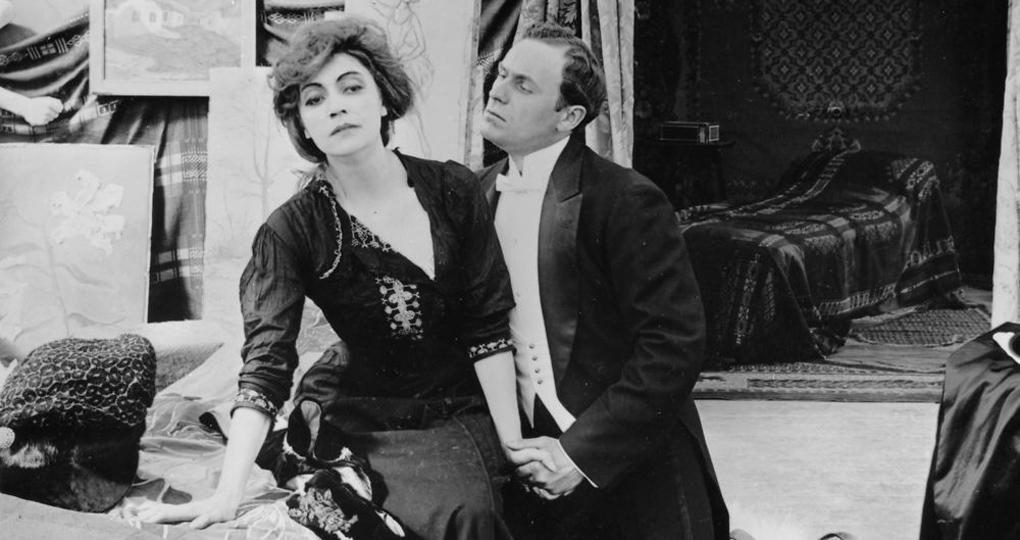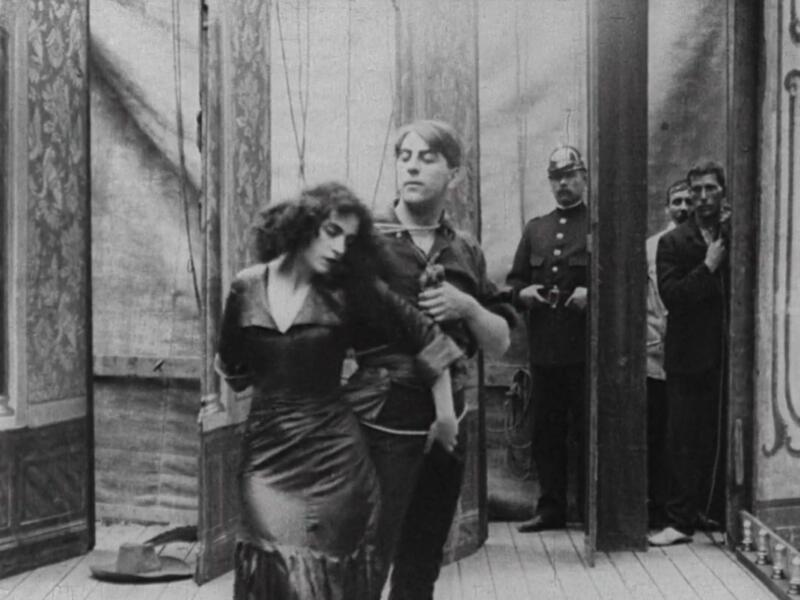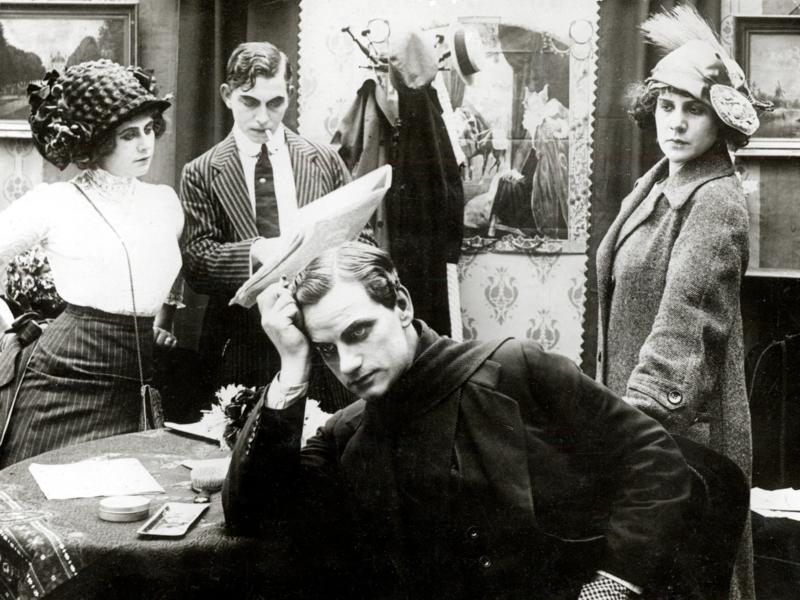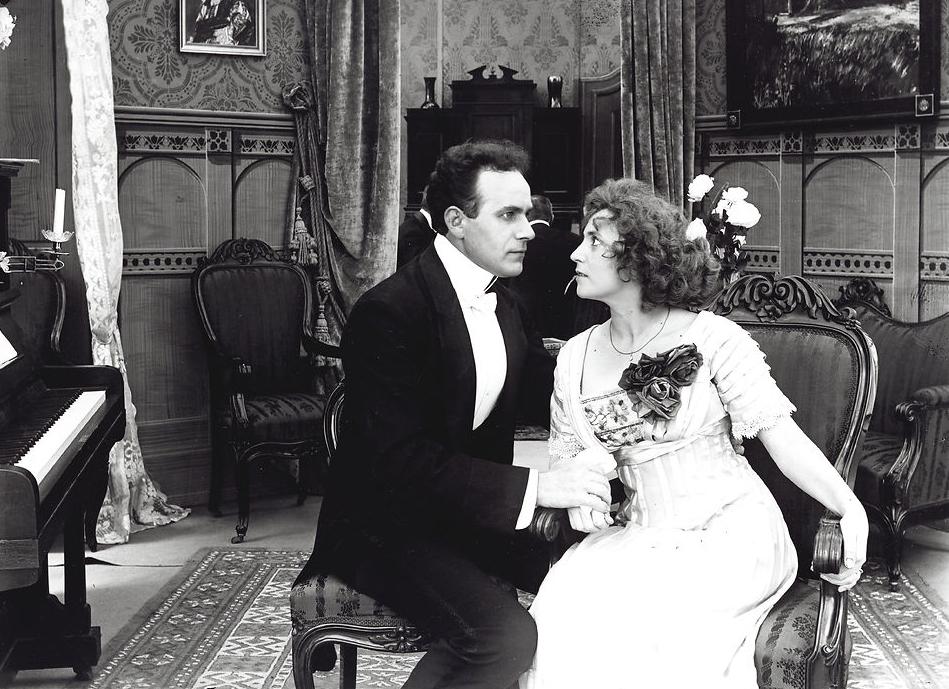
1911 was a year of big changes in the Russian film trade. Since the early 1900s, French Pathé and Gaumont had dominated the huge Russian market, but Russian fiction films began being produced by 1908. The first years of Russian film production were marked by competition between Pathé’s Moscow office and a few pioneering Russian film producers, such as Aleksandr Khanzhonkov’s trading house and Aleksandr Drankov. Since the beginnings of cinema, Pathé’s films d’art had set the standard for Russian film production, which consisted largely of one-reel historical films and adaptations of classic Russian literature. However, by 1910, the age of the one-reeler was coming to an end. The biggest events of the season 1910–1911 were the Danish films Den hvide Slavehandel ( 1910, August Blom, lit: The White Slave Trade) and especially Urban Gad’s Afgrunden (The Abyss). Longer than any films that had been seen before, they changed earlier conceptions of film aesthetics, film distribution (the monopoly-distribution system), and film advertising. By the autumn of 1911 these changes had made their way into the Russian production system (Piispa 2013, 247–252).
That fall the first films featuring Valdemar Psilander were shown in Russia. Nordisk Films Kompagni’s films were already known to Russian audiences, as the company’s films had been distributed to Russia since 1908–1909. In April 1911 Nordisk signed an exclusive contract with the distribution company Thiemann & Reinhardt (later Thiemann, Reinhardt & Osipov) (Thorsen 2009, 81). The trading house Thiemann & Reinhardt is a success story of the pre-war Russian film trade. It was founded in 1909 by Paul Thiemann, a former director of Gaumont’s Moscow office, and the tobacco merchant Friedrich Reinhardt. Besides Nordisk the company held exclusive rights to the films of Italian Ambrosio and American Vitagraph, as well as running their own production line under the trademark ”Russian Golden Series”. The most informative source on Psilander’s films in Russia is Cine-Phono, the film trade journal which, although officially independent, was linked to Thiemann & Reinhardt through personal and economic ties (Чернышев 1987, 113–115). By the end of 1911 Psilander had been seen in at least En Lektion (1911, August Blom, lit: A Lecture), Mormonens Offer (1911, August Blom, lit: A Victim of the Mormons), Balletdanserinden (1911, August Blom, The Ballet Dancer), and Det bødes der for (1911, August Blom, lit: You are Held Accountable).1

Psilander’s name was not yet mentioned in advertising for these films, however. According to Isak Thorsen (2009, 148–149), Nordisk kept the names of their actors a secret until 1911, when the success of the feature film prompted Nordisk to change its policy completely. In Russia, the practise of featuring actors’ names was also unusual at the time. Max Linder’s name had appeared in advertisements as early as 1909 but that was an exception. Asta Nielsen became a phenomenon with The Abyss in 1910 without anyone apparently knowing the name of the scandalous ‘gaucho dancer’. Nielsen’s name first began appearing regularly in August 1911 when the first Urban Gad–Asta Nielsen series was launched (Piispa 2013, 252). In the Nielsen–Psilander film The Ballet Dancer, her name was featured in Russian advertisements, but Psilander had to charm his admirers anonymously.
“Mr. Garrison”
The new practice of advertising films with the leading actor’s names became evident in the Russian advertising for Psilander’s films in March 1912 when a full page advertisement of Livets Baal (1912, Eduard Schnedler-Sørensen, lit: Fire of Life, released 26.3.1912 with a Russian title Под знаменем науки) appeared in Cine-Phono, with Psilander’s portrait and a
caption introducing the Russians to “the famous Danish actor, Mr. Garrison” (Сине-фоно 11/1912). ‘Garrison’, as the name ”Harrison” is spelled in traditional Russian orthography, is the screen name under which Psilander became known and how he is often still referred to in Russia. Credit for Psilander’s pseudonym belongs to Iakov Protazanov (1881-1945), the future prominent film director, who was at the time employed by Thiemann & Reinhardt. In his memoirs, Protazanov wrote:
Part of my job was to invent better-sounding and -selling names for artists in cases where their real names sounded strange in Russian pronunciation. Thus, I am the author of a number of popular artists’ names. For instance, I christened a certain Norwegian, who was later very popular, with the name “Garrison.” His real name was Psilander. You just couldn’t expect any success with a name like that! (Протазанов 1957, 296–297)
Protazanov’s comment illustrates the difficulty many Russians had in identifying Psilander and Nordisk’s home country. In many memoirs, they are called”Swedish”, ”Norwegian”, ”Northern,” etc. but practically never Danish.
However, despite Protazanov’s claims, renaming a foreign film actor was not in any way standard practice in Russia. Russian screen names were sometimes invented for comedians, such as André Deed, who was known in Russia as ”Glupyshkin” (”Dopey”), or John Bunny, known as ”Poxon” – another pseudo-Western name made up by Protazanov. Dramatic actors usually got to keep their own names. Of Psilander’s colleagues at Nordisk only Ebba Thomsen was rechristened, as ”Eva”. What was so wrong with the Greek name Psilander is hard to guess. Perhaps it was the beginning ‘psi’, which evokes the colloquial and not exactly flattering term psikh (weirdo). Even with a new name, it took some time for Psilander to stand out in the Russian market. Unlike his closest rivals the Danish actress Asta Nielsen and the French actor Max Linder, he was not a star on his own but as a member of an ensemble, a part of Nordisk’s trademark.
Nordisk became popular as a company in Russia first, with Psilander’s individual popularity developing afterward. A typical slogan in the reviews of Nordisk’s productions, which was applied to other actors of the company as well as Psilander, was “the names of the actors speak for themselves.” In 1911, the quality of Nordisk films was superior to most of its competitors, especially compared to the Russian productions of those years. For instance, until 1912 Russian films were filmed in outdoor pavilions in natural light while Nordisk had been filming indoors with artificial lighting for years. More importantly, the realistic acting of Danish films was considered exemplary at the time when feature film changed film aesthetics profoundly. In 1918, film director Boris Chaikovskii recalled being frustrated at the quality of Russian production of 1911. He wrote about the revelation of seeing Kinografen’s’De fire Djævle (1911, Robert Dinesen, lit: The Four Devils, released in Russia as Четыре черта), a film which, although it did not star Psilander, became very popular at the time of his own early films:
The answer came not from the East but from the North, where you could least expect any new revelations. – – – [The Four Devils] was one of the first films to reach a length of 1,000 meters because the actors played in a tempo of the events they were representing. And, most importantly, they tried to perform and represent everything as close to life as possible. (Чайковский 1918, 2)
In the early 1910s there was an insatiable demand on the Russian market for feature length dramas with great actors, and Nordisk was best able to provide these on a regular schedule and in uniform quality.
Psilander’s rising star
If at first Psilander was just another face in the Nordisk catalogue, his hold of the Russian audience gradually grew stronger. One indicator of this, which can be found in published synopses of Psilander’s films, is that by 1913 the Russian distributor had begun replacing the names of Psilander’s characters in various films with the name ‘Garrison’, thus making Psilander not only the star but also the protagonist of his films. The practice was extended to at least one film title as well: the comedy Nellys Forlovelse (1913, Eduard Schnedler-Sørensen, lit: Nelly’s Engagement) was distributed as Кумир Гаррисона (”Garrison’s Idol”) (Сине-фоно 26/1913). This echoes the treatment of Max Linder’s films, the titles of which usually featured the name of the star-protagonist ”Max”, as for example in Max gets Married.
No doubt, it was Psilander’s diverse talents, suitable for action and romance as well as comedy that made him stand out from his Nordisk colleagues.
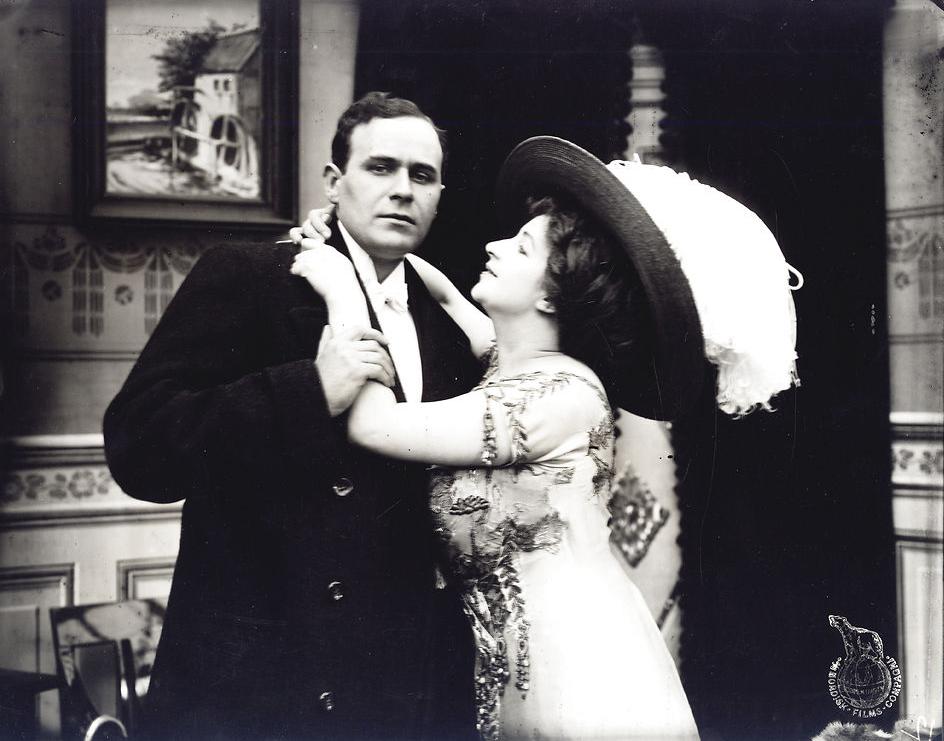
As a review from 1913 put it,
Garrison, who has all the sympathies of the audience, especially the female half of it, is an artist of inimitable talent, who can easily and jokingly master any role no matter how difficult. What makes his performances special is that, while he always remains himself, he is at the same time different in different roles. (Сине-фоно 19/1913, 23).
Another review offered a more tongue-in-cheek explanation for Psilander’s success:
We shall not stop at the plot itself, we shall only point out the scenes where Garrison is at his best. They are the scenes where he and the heroine play a love duet, where Garrison performs in the music of love a spectrum of emotions that will cause the few remaining ladies who have not yet succumbed to his charms to fall at his feet. (Сине-фоно 4/1913, 28)
Reviews in a trade journal like Cine-phono should be regarded as examples of marketing strategies, however, not objective observations.
Whether Russian women actually swooned over Psilander’s talents is not disclosed by the available sources. Audience surveys from different ends of the Russian empire reveal that the image of the women’s favourite does not show the whole picture of Psilander’s fame. In 1913, audiences of the cinemas Modern in Kharkiv (present-day Ukraine) and Illusion in Tomsk (Central Siberia) were asked to check the names of the film artists they liked best. In Kharkiv, ‘Garrison’ was voted the favourite dramatic actor, with Asta Nielsen winning the dramatic actress and Max Linder the comic category (Сине-фоно 8/1913, 31). In Tomsk, ‘Garrison’ emerged as the audience’s second favourite male artist, losing by a neck to Linder, with Nielsen winning the female category there as well (Сине-фоно14/1913, 29). Practically all survey respondents liked these three, and as most of those who responded were men, it is clear that Psilander was liked by men and women alike. The other Nordisk artists did also well; for example, Robert Dinesen and Lilli Beck got many votes in both cities.
1913 turned out to be the peak of Psilander’s success story in Russia. His European tour of 1914 interrupted the steady flow of Garrison pictures in the spring. For one reason or another, Psilander’s planned visit to Russia in Easter 1914 never came about, although he had told the Berlin correspondent of Russian Cine-Journal in January: ”I have always been drawn to Russia. This is why I am very happy for the chance to visit your country. I will do a few shows in St. Petersburg, Moscow, and Warsaw” (Кине-журнал 2/1914, 33). A visit from Psilander would doubtlessly have caused a similar craze as Max Linder had on his Russian tour in November-December of the previous year (Tsivian 1994, 129-135).
The interruption in the supply of Psilander films did not affect Nordisk’s success in Russia. Thiemann & Reinhardt’s competitors did their best to get their hand on the Danish gold. In February, Nordisk placed an announcement in Cine-phono stating that, despite many inquiries, Russian distribution of Nordisk’s films would remain in the hands of Thiemann & Reinhardt (Сине-фоно 10/1914, 52-53). The Psilander famine ended the next autumn, with twenty new Garrison films advertised by Thiemann & Reinhardt (Сине-фоно 18/1914, 12-13). By that time the company had become close to a market leader. The same summer they added the new Asta Nielsen series to their catalogue and expanded their ”Russian Golden Series” with lavish adaptations of Tolstoy’s Anna Karenina, Turgenev’s Home of the Gentry, and other Russian classics directed by the company’s in-house directors Vladimir Gardin and Iakov Protazanov. In July,Thiemann & Reinhardt also announced the opening of a new office in Berlin (Сине-фоно 20/1914, 14).
When World War I broke out in August 1914, however, the company’s tight connections to Germany and the German nationality of the management cost Thiemann & Reinhardt dearly. Not only was their studio nearly burned down in the anti-German pogrom of the first days of war (Янгиров 2002, 33), but, even more importantly, the war isolated Russia from the European film market. Importing films became practically impossible by the German blockade of the North Sea. However, in late August, Thiemann & Reinhardt announced that with great effort and cost they had managed to secure contacts which enabled them to bring in Nordisk’s films, including ones featuring Garrison (Сине-фоно 23-24/1914, 12), on a route that apparently went through Sweden and Finland (Форестье 1945, 67). It was nevertheless not until January 1915 that Et Læreaar (The Reformation, 1914, August Blom, Russian title Раб золота и баловень судьбы) ended Psilander’s long absence from the Russian screen (Сине-фоно 6–7/1915).
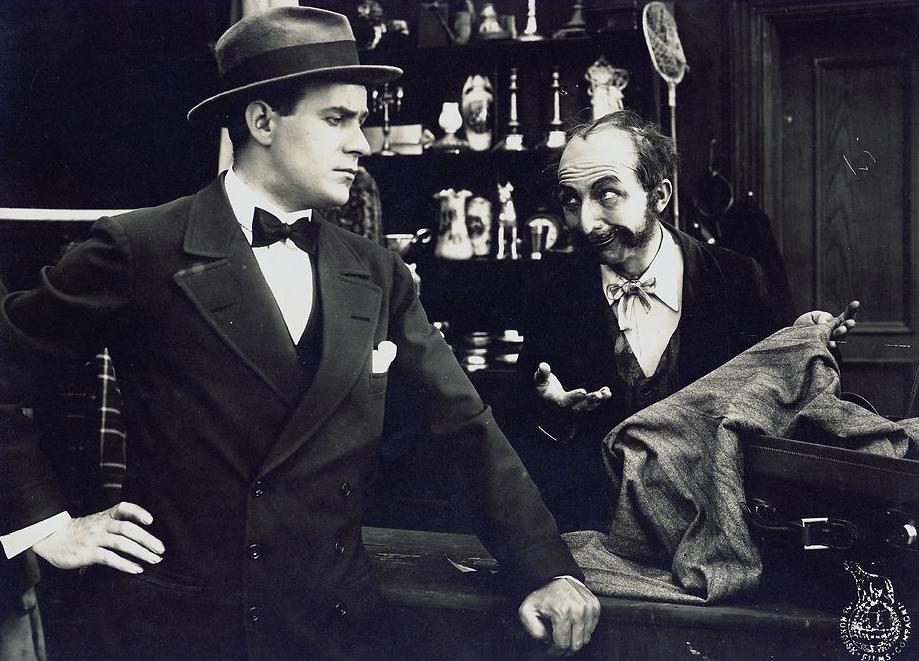
Trouble and tributes
Of the leading pre-war star-trio of Linder-Nielsen-Garrison, Psilander was the only one whose films were shown regularly in Russia during the war, but his position as a leading star was undermined by many new obstacles. At first Thiemann & Reinhardt seemed able to manage in the new circumstances, but ironically, the same nationalistic sentiments that contributed to the success of their own ”Russian Golden Series” brought them trouble. A new setback for the company came in May 1915 when Paul Thiemann and Friedrich Reinhardt were deported from Moscow, along with other German citizens (Янгиров 2002, 33–35). The company Thiemann, Reinhardt & Osipov managed to stay afloat until 1917 and to keep their Nordisk’s contract in hand, despite competitors that tried to either steal Nordisk’s business from them or spread rumours that Nordisk was a German company (Thorsen 2009, 204–205). Nordisk never turned its back on its Russian partner. On the contrary, in 1915 the two companies renewed their contract for the next five years and Thiemann, Reinhardt & Osipov promised a new ‘Garrison’ picture every two weeks (Сине-фоно 19-20/1915, 67-68). In October 1916, Nordisk bought half of the trading house, thus consolidating its foothold in Russia (Thorsen 2009, 205–206). While films starring ‘Garrison’ still ran in Russian film theatres for appreciating fans during the war years, Psilander never quite regained his pre-war star status. Wartime shortages came as a godsend for the Russian production companies who soon took over the territory left by the lack of foreign films. This cleared the way for Russian actors to win the hearts of the audiences.
Yet while Psilander’s popularity declined, his and other Nordisk actors’ influence on Russian film acting is unquestionable. One unlikely but authoritative admirer was Vsevolod Meyerhold (1874–1940), the great Russian theatre modernist, who in 1915 directed the first of his two films for the ”Russian Golden Series”. Meyerhold’s concern throughout his theatre career was the cultivation of actors’physical technique and rhythm. Preparing for his debut as a film director Портрет Дориана Грея (1915), based on Oscar Wilde’s The Picture of Dorian Gray, Meyerhold reflected upon the special requirements the cinema placed on the actor: “Often we see that wonderful artists of drama and ballet are completely unfit for the screen…. Yet, on the other hand, someone like Garrison, who has no special actor’s education, has intuitively learned to master the specific technique that cinema requires” (Театральная газета 22/1915, 7). Meyerhold had no way of knowing that Psilander had left his theatre work after a screen debut in an earlier adaptation of The Picture of Dorian Gray (1910, Axel Strøm).
What Meyerhold meant by specific cinema technique is not entirely clear. Vladimir Gardin, a director of the ”Russian Golden Series” and an early theorist of film performance, was more precise: he defined ‘Garrison’, along with Asta Nielsen, as representative of what he called the ”breaking school” of film acting (Гардин 1949, 151). By this he meant the actor’s pausing every once in a while to express deep emotions. According to Gardin, Ivan Mozzhukhin was the first actor in Russia to act this way. Mozzhukhin became a leading figure in Russian cinema in the early 1910s, first in Aleksandr Khanzhonkov’s productions and later in Iakov Protazanov’s films at the Ermolev Studio during the war. Psilander’s influence is perhaps evident especially in some of Mozzhukhin’s early roles but as a star he represented an altogether different type, borrowing more from nineteenth-century stage tragedians, changing his appearance from role to role and introducing a demonic element into his ‘neuraesthenic’ characters.
Another early favourite whom some scholars have described an imitator of Psilander was Vladimir Maksimov, an actor at the Imperial Maly Theatre and in the ”Russian Golden Series” (Leyda 1983, 60; Гинзбург 1963, 329). Practically all of Maksimov’s films have been lost, so the comparison seems to be based on Maksimov’s physical resemblance to Psilander. On the other hand, in 1915 Dmitri Kharitonov initiated his production company with a strategy similar to Nordisk: a permanent star ensemble and scripts tailored for specific actors with a set star image. The company boasted a line-up of Psilander-like ‘heroes in tailcoats’, including Maksimov, Vitold Polonsky, Ivan Khudoleyev, and Osip Runich. The recipe made Kharitonov the greatest success of the last years of tsarist film industry, 1917-18 (Гинзбург 1963, 194–195).
In revolutionary Russia in 1917, Psilander’s death was reported only briefly and after a two month delay (Проэктор 9–10/1917, 16). Just prior to the October revolution, Thiemann, Reinhardt & Osipov was divided into several independent companies all of which soon disappeared from the pages of film history (Янгиров 2002, 35). This marked the end of Psilander’s star presence in Russia, but the story comes with an epilogue. In December 1917, Aleksandr Drankov, who is remembered as the producer of the first Russian fiction film Стенька Разин (1908), announced among his forthcoming films a biopic Жизнь Гаррисона (‘The Life of Garrison’) (Кине-журнал 17–24/1917, 62). However, by the time this advertisement came out the Bolsheviks had already seized power in Moscow and Petrograd. The next summer Drankov, like many of his colleagues in the film business, fled to Ukraine. It appears that The Life of Garrison was finished in 1918 in Crimea, where a colony of Russian film entrepreneurs waited in vain for the Soviet state to collapse, and from where they soon went into exile (Янгиров 2005, 118). A Russian filmography states that the film was probably never released (Вишневский 1961, 263). As interesting as it would be to see a Russian rendering of Psilander’s life, the film is lost and there is no information about either the film itself or Mr. Galitsky, the actor who not only played the leading role but also wrote and directed the last Russian tribute to Valdemar Psilander.
BY: LAURI PIISPA / RESEARCH FELLOW AT THE UNIVERSITY OF TURKU
Notes
1. Russian titles and release dates respectively: Авиатор и жена журналиста, 16.8.1911 (Сине-фоно 20/1911); Жертва мормонов, 20.9.1911 (Сине-фоно 23/1911); Зачем так любила!, 4.10.1911, (Сине-фоно 24/1911); Мщу за честь, 3.11.1911 (Сине-фоно 3/1911).
References
Leyda, Jay (1983). Kino. A History of the Russian and Soviet Film. Third Edition (First Edition 1960). Princeton, Princeton University Press.
Piispa, Lauri (2013). ”Asta Nielsen and the Russian Film Trade”. In: Martin Loiperdinger and Uli Jung (eds): Importing Asta Nielsen. The International Film Star in the Making 1910–1914. KINtop Studies in Early Cinema – volume 2. London, John Libbey Publishing.
Thorsen, Christian Isak (2009). Isbjørnens anatomi: Nordisk Films Kompagni som erhvervsvirksomhed i perioden 1906-1928. (Ph.d.-afhandling). Københavns Universitet.
Tsivian, Yuri (1994). ”Russia, 1913. Cinema in the Cultural Landscape”. In Griffithiana 50: Il Cinema nel 1913/The Year 1913.
Вишневский, В.Е. (1961). «Каталог фильмов частного производства (1917–1921)». In: Советские художественные фильмы 3. Москва, Искусство.
Гардин, В.Р. (1949). Воспоминания. Т. 1: 1912–1921. Москва, Госкиноиздат.
Гинзбург, Семён (1963): Кинематография дореволюционной России. Reprint: Москва, Аграф 2007.
Форестье, Луй (1945). Великий немой (Воспоминания кинооператора). Москва, Госкиноиздат.
Протазанов, Яков (1957). «Протазанов о себе». In: М.Н.Алейников (сост.): Яков Протазанов. О творческом пути режиссера. Москва, Искусство.
Чайковский, Борис (1918). «Записки режиссера» In: Киногазета № 2 (январь) 1918.
Чернышев, А.А. (1987). Русская дооктябрьская киножурналистика. Москва, Издательство Московского университета.
Янгиров, Рашит (2002). «Киномосты между Россией и Германией. Эпоха иллюзионов (1896–1919)». Reprinted in: Янгиров, Рашит: Другое кино. Статьи по истории отечественного кино первой третьи XX века. Москва, НЛО 2011.
Янгиров, Рашит (2005). «Голливудские миражи Александра Дранкова». Reprinted in: Янгиров, Рашит: Другое кино. Статьи по истории отечественного кино первой третьи XX века. Москва, НЛО 2011.
Suggested citation
Piispa, Lauri (2017): Garrison, Star of the Russian Screen. Kosmorama #267 (www.kosmorama.org).
Watch the films at Stumfilm.dk:
